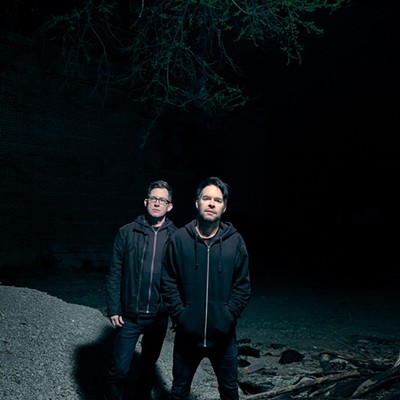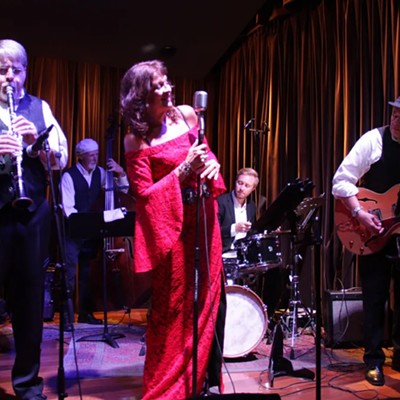But since 1985, the now-42-year-old singer-songwriter has released six studio albums of solid, insightful songwriting and increasingly adventurous music that resists the too-easy categorization of folk singer.
Following on the heels of her 2001 album, Days of Red and Gray, the New York City-based Vega will visit Tucson for a concert Thursday, July 18, at the Backstage. The eastside nightclub's close and cozy environs are certain to make for an intimate performance, during which Vega will be accompanied by a four-piece backing band.
Released last fall, Days of Red and Gray was Vega's first album of new material in five years, following 1995's Nine Objects of Desire. Some of the new record deals overtly or tangentially with the life changes she experienced during that time, including a divorce from her husband and producer Mitchell Froom. As break-up albums go, it's nearly as moving as Richard and Linda Thompson's monumental Shoot Out the Lights.
The new record was produced by English knob-twiddler Rupert Hine, and it marks a break from the eccentric, sometimes-industrial sound designs Vega created with Froom behind the board. In fact, it marks a bold return to acoustic-based folk songs.
Vega is concerned with not only the voices of the characters in her songs, but with finding her own voice as an artist and a person. The quest for individuals to tell their unique stories is a pursuit that is one of life's challenges and joys, she has said.
"Everybody has a different perspective. Everyone is uniquely individual. If you're going to talk about your life, you need to find the right words," Vega said in an on-line interview with Paul Waldman.
"I'm really hard to categorize because I was raised as a half-Puerto Rican, half-Buddhist folk singer. That's a pretty strange combination. Therefore, I feel that I'm likely to say things from a different perspective. But I believe that everyone can. I think that every person is unique, even if he or she comes from the most ordinary middle-class family. There's always something that makes your perspective slightly different from your brother's."
But Vega hopes her songs also can be read as allegories that apply to the lives of others as well.
In her recent record-company biography she said, "If you're going to write about your life, the worry is that it's too personal. So I find that I'm writing with metaphors, which means that even though I'm writing about personal things, I can use images that are more powerful than just to say, 'I felt sad.'"
Born in Santa Monica, Calif., Vega grew up in Spanish Harlem in New York City, raised by her mother and her stepfather, the Puerto Rican writer Ed Vega, whom she assumed for years was her biological father. Learning her real father was Anglo sparked an identity crisis that was resolved when she reunited with her dad some 20 years later.
A one-time dancer, she studied at Barnard College and hung out in the cafes and folk-music clubs of Greenwich Village. Polishing her music until she won a record contract--on the third try from A&M Records--Suzanne Vega was infatuated early on with the music of Leonard Cohen and Lou Reed. Her highly intelligent and literate lyrics exhibit the naked emotions of those artists as well as the finely crafted verbosity of Elvis Costello.
Vega was a serious female musician well before such a role was an accepted mainstream-label commodity. Although some folks may compare her work to that of girl-power artists such as Sheryl Crow, Alanis Morrisette and Jewel, Vega's no pop tart. Her conscience, scope and lyrical richness draw comparison to more apt contemporaries such as Costello, Steve Earle, Duncan Sheik, Natalie Merchant and the late Jeff Buckley.
But Vega's recent work isn't limited to Days of Red and Gray. The paperback edition of her book The Passionate Eye: The Collected Writing of Suzanne Vega was published last year. And in 1998, the album Tried and True: The Best of Suzanne Vega was released in nearly every country except the United States.
She works actively on behalf of children's and human rights through the groups Amnesty International and Casa Alianza. Last year, she also was a judge for the Orange Prize in Fiction, which is awarded to books written by women.
A New Yorker for most of her life, Vega felt horror and pain after the terrorist attacks of Sept. 11. Compelled to express such feelings, she wrote the song "It Hit Home," and included it on a CD collection, Vigil, released by the new record label Conscious Music, started by Vega's manager, Nancy Jeffries.
Also on the disc are 19 other songs by members of the Greenwich Village Songwriters Exchange--a long-running writing workshop led by folk artist and Vega mentor Jack Hardy--in which Vega still retains membership. Among the artists on the acclaimed album are Jack Hardy, Christine Lavin, Bob Hillman, Tim Robinson, Wendy Beckerman and Frank Tedesso.
Hillman, by the way, is on tour with Vega and in his comfortably ragged voice will open the show for her at the Backstage. He'll play acoustic selections of thoughtful and sardonic songs from his two albums, Welcome to My Century and Playing God.








